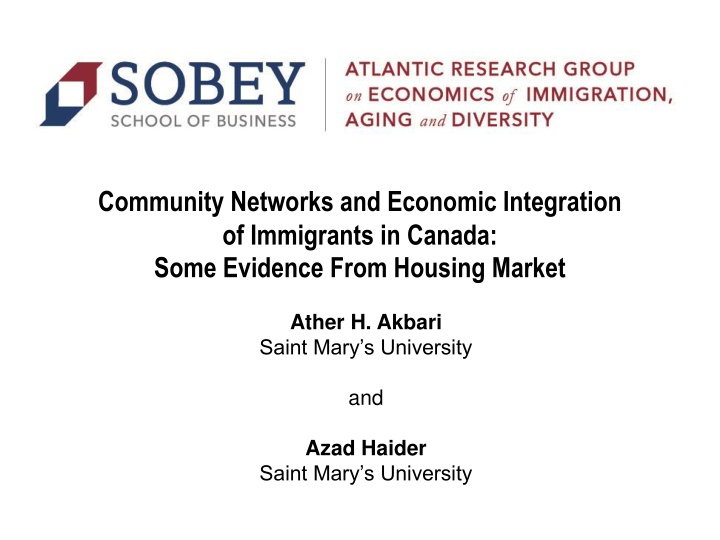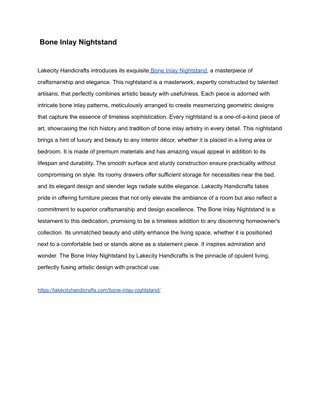
Economic Integration of Immigrants in Canada: Housing Market Evidence
Explore the economic integration of immigrants in Canada through the lens of housing market dynamics, emphasizing the role of community networks. Learn about the importance of immigrant networks, measures of economic integration, and the impact of homeownership. Discover how search theory in economics and descriptive statistics contribute to understanding immigrant settlement programs.
Download Presentation

Please find below an Image/Link to download the presentation.
The content on the website is provided AS IS for your information and personal use only. It may not be sold, licensed, or shared on other websites without obtaining consent from the author. If you encounter any issues during the download, it is possible that the publisher has removed the file from their server.
You are allowed to download the files provided on this website for personal or commercial use, subject to the condition that they are used lawfully. All files are the property of their respective owners.
The content on the website is provided AS IS for your information and personal use only. It may not be sold, licensed, or shared on other websites without obtaining consent from the author.
E N D
Presentation Transcript
Community Networks and Economic Integration of Immigrants in Canada: Some Evidence From Housing Market Ather H. Akbari Saint Mary s University and Azad Haider Saint Mary s University
Introduction Economic integration of immigrants is an important focus of public debate in immigrant receiving countries. With larger numbers of immigrants now arriving in smaller areas, smaller communities are also taking greater interest in their economic integration.
Some definitions Migrant networks: interpersonal ties linking kin, friends, and community members in their places of origin and destination. (Massey et al (1993). Economic integration: Minority participation in mainstream socioeconomic institutions (e.g., labour market) on the basis of parity with ethnic-majority individuals of similar socio- economic origins. (Alba and Nee (1997).
Importance of the research question To assess the importance of the role of networks in immigrant settlement programs. Important study for smaller provinces where strong networks are not yet established.
Measures of economic integration Four key measures of economic integration: Citizenship Homeownership Job status Earning (better income)
Importance of homeownership Most important investment in one s lifetime Provides greater privacy and security An important signal of commitment to life in Canada Social externality
Search theory in economics Search theory Individuals search for a product or for a job until the benefit from additional search exceeds the cost of it (Stigler) Role of networks Help reduce the cost by providing information. Determine whether and where an immigrant buys a house in the host country (Borjas, 2002; Filpen 2001, Gabriel and Painter 2003, Haan 2005).
Table 1: Occupied private dwellings by condition of dwelling and Period of Construction (%) Major repairs Period of Construction Non- Established Immigrants (1981-2006) Non- Immigrants Established Immigrants Visible Minority Group Immigrants (1981-2006) Black South Asian 11.4 5.4 9.4 5.0 36.5 41.9 58.3 52.7 61.9 61.0 Chinese South East Asian 6.2 8.1 5.7 6.8 42.3 51.8 49.7 46.4 Filipino Arab/West Asian 7.2 7.2 6.5 6.3 42.1 47.4 Latin American 13.5 9.8 35.4 39.0 37.2 39.0 Canada 7.5 7.5
Table 2: Total number of occupied private dwellings by number of rooms and number of bedrooms Number of Bedrooms (0-3 bedrooms) Non- Immigrants Immigrants Number of Rooms (1-4 rooms) Non- Immigrants Visible Minority Group Established Established Immigrants Black South Asian 40.3 34.9 86.8 76.1 36.5 30.7 20.8 24.1 75.3 75.1 54.5 60.8 Chinese South East Asian 40.4 41.6 28.3 31.9 86.3 87.5 71.9 70.1 Filipino Arab/West Asian 33.0 31.7 78.0 72.3 Latin American 44.8 25.5 35.0 25.5 77.3 87.3 79.4 77.3 Canada
Table 3: Total number of occupied private households by tenure Owned Rented Visible Minority Group Non- Immigrants Established Immigrants Non- Immigrants Established Immigrants Black South Asian 39.3 49.2 60.7 50.8 61.5 71.1 79.3 83.5 38.5 28.8 20.7 16.5 Chinese South East Asian 46.2 52.2 67.7 67.7 53.8 47.8 32.3 32.3 Filipino Arab/West Asian 59.9 60.8 39.9 39.2 Latin American 42.2 68.4 49.6 68.4 57.8 31.6 50.4 31.6 Canada
Table 4: Total number of occupied private households by Average Value of Dwelling and by Average Household Income Average Value of Dwelling Non- Immigrants Average Household Income Non- Immigrants Visible Minority Group Established Immigrants Established Immigrants Black South Asian 247729 272247 49128 58782 384298 402183 346214 414827 76110 87365 86960 77841 Chinese South East Asian 266711 273666 343900 283701 51070 66052 65875 80521 Filipino Arab/West Asian 287561 347431 64044 66046 Latin American 251940 263369 264553 263369 50614 69548 59728 69548 Canada
Chart 1: Home ownership rates among visible minority immigrants in Canada 100 100 90 90 80 80 70 70 60 60 50 50 40 40 30 30 20 20 10 10 0 2001-06 0 2001-06 1996-00 1991-95 1981-90 1971-80 1961-70 Before 1961 1996-00 1991-95 1981-90 1971-80 1961-70 Before 1961 Non-Immigrants Black Non-Immigrants South Asian 100 100 90 90 80 80 70 70 60 60 50 50 40 40 30 30 20 20 10 10 0 2001-06 0 2001-06 1996-00 1991-95 1981-90 1971-80 1961-70 Before 1961 1996-00 1991-95 1981-90 1971-80 1961-70 Before 1961 Non-Immigrants Chinese Non-Immigrants Southeast Asian /Fillipino 100 100 90 90 80 80 70 70 60 60 50 50 40 40 30 30 20 20 10 10 0 2001-06 0 2001-06 1996-00 1991-95 1981-90 1971-80 1961-70 Before 1961 1996-00 1991-95 1981-90 1971-80 1961-70 Before 1961 Non-Immigrants Arab/West Asian Non-Immigrants Latin American
Data and Methodology Regression analysis to estimate a demand model 2006 census based data Unit of analysis is a visible minority group resident in a Census Metropolitan Area (CMA). 8 visible minority groups resident in 14 different CMAs are considered. Feasible Generalized Least Square (FGLS) Pooled Corrected Standard Error (PCSE)
Basic Demand Model for Homeownership HRATE = 0+ 1PRICE + 2 INCOME + 3 HHSIZE + 4UR+ 5 (Vismin/POP) + 6 RPOP PRICE is the average price of a house paid by a community member INCOME is the average household income in the community HHSIZE represents household size in the community UR is the unemployment rate in the community Vismin/POP is the % composition of Vismin in a CMA population RPOP is the % composition of recent Vismin immigrants in Vismin population
Extended Demand Model for Homeownership HRATE = 0+ 1PRICE + 2 INCOME + 3 HHSIZE + 4 UR + 5 (Vismin/POP) + 6RPOP + 7 (D1*Vismin/Pop)+ 8 (D2* Vismin/POP) D1 = 1 if the CMA is in Atlantic Canada and zero otherwise D2 = 1 if the CMA is in the Saskatchewan & Manitoba provinces and zero otherwise. The coefficients, 7and 8 each compares the effect of a Vismin population on homeownership rates in CMAs of Atlantic Canada and CMAs of Saskatchewan & Manitoba provinces, with the CMAs in the rest of Canada.
Table 5: Regression Results of Homeownership Model Coefficient t-statistic P-value Variable Constant 47.00905 5.781239 0.0000 Price($) -1.32E-05 -1.24367 0.2164 House hold Income ($) 0.000422 6.79698 0.0000 Household Size (HS) 0.397244 0.180803 0.8569 Unemployment (Rate) -0.46913 -1.99199 0.0490 Ratio of Total Vismin CMA Population to Total CMA Population 1.151143 2.969753 0.0037 Ratio of Recent Vismin Immigrants to Vismin Immigrants -0.33493 -5.25658 0.0000 0.52 SE of Reg. 12.557 R2 0.49 F-Statistic 112 Prob. (F-Stat) 18.5796 0.0000 Adjusted R2 No of Obs.
Table 6: Regression Results of Homeownership Model With Population Effects in Smaller Provinces Coefficient 46.46778 -1.01E-05 0.00043 -0.01674 -0.36057 t-statistic P-value 0.0000 0.3773 0.0000 0.9937 0.1272 Variable Constant Price($) House hold Income ($) Household Size (HS) Unemployment (Rate) Ratio of Total Vismin CMA Population to Total CMA Population (TPop) Ratio of Recent Vismin Immigrants to Vismin Immigrants Dummy variables (Base on provinces other than in Atlantic Canada, Saskatchewan and Manitoba) (D1) * Population (TPop) (D2) * Population (TPop) R2 Adjusted R2 No of Obs. 5.914269 -0.88673 7.01896 -0.00788 -1.53766 1.051657 2.694282 0.0082 -0.32937 -5.35523 0.0000 -4.36423 0.576712 0.52 SE of Reg. 0.49 F-Statistic 112 Prob. (F-Stat) -1.43194 0.522211 0.1552 0.6026 12.6272 14.0934 0.0000
Some conclusions and policy implication Community networks, as represented by their resident population in a CMA, are important determinants of the homeownership rate in a visible minority group. A 1 percent increase in the composition of visible minorities in a CMA population increases home ownership rate in that group by 1.05 percent. The effect of a resident visible minority population in a CMA is no different in smaller provinces than it is in larger provinces. Settlement policy should encourage community participation in immigrant integration.






















